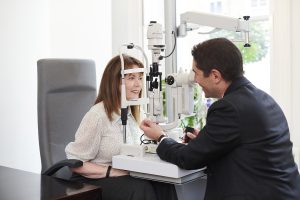Am I a good candidate for LASIK based on my refractive error?
LASIK is the most commonly performed Laser Eye Surgery procedure in the UK – and has been since the late 1980s. Having such a long history (relative to Laser Eye Surgery) means that most patients eligible for Laser Eye Surgery are suitable for LASIK; however, there are exceptions.
In this article, we will briefly explain the difference between LASIK and other Laser Eye Surgery procedures (PRK/LASEK and ReLEx SMILE), the refractive errors (and prescriptions) that are suitable for LASIK treatment, as well as any factors that could make you unsuitable.
So, to kick off, let’s take a closer look at LASIK: What is it and how does it differ from other Laser Eye Surgery procedures?
What is LASIK Laser Eye Surgery?
LASIK, or laser-assisted in situ keratomileusis, like all Laser Eye surgery procedures, involves reshaping the cornea. This is achieved with a high-precision laser which is used to remove tissue, but before this can be done, the surgeon needs to access the cornea through the epithelium.
In LASIK, a laser is used to create a small flap in the epithelium. This allows access to the cornea for reshaping and for removed tissue to be drawn out of the eye. Once this stage is complete, the corneal flap is simply put back in place where – thanks to the amazing healing power of the eye – it begins to reattach almost immediately.
In contrast, PRK/LASEK – known as surface procedures – and ReLEx SMILE each take a slightly different approach.
SMILE involves creating a tiny ‘keyhole’ in the eye between the surface of the corneal bed. With the most up-to-date technology, surgeons can reshape the cornea and draw out tissue through this tiny hole.
On the other hand, PRK/LASEK involves removing a whole section of the epithelium. This grows back naturally but the eye takes longer to heal than in LASIK or SMILE, so a protective contact lens is worn initially to shield the eye from potential damage.
What are the Suitability Criteria for LASIK Laser Eye Surgery?
As we mentioned above, LASIK is still by far the most commonly performed Laser Eye Surgery procedure. This means that the majority of people who are eligible for Laser Eye Surgery are suitable for LASIK treatment. However, there are some things that can make a patient unsuitable – for example, your prescription.
Ongoing innovation in the Laser Eye Surgery field means that we are now able to treat higher prescriptions than ever before. LASIK can be used to treat the three main types of refractive error: hyperopia (long-sightedness), myopia (short-sightedness), and astigmatism.
LASIK for Myopia (Short-sightedness)
Myopia, also called short- or near-sightedness, is the most common refractive error, worldwide. It is characterised by difficulty seeing objects at a distance, even when your near vision is fine.
Generally speaking, we are able to treat myopia up to a prescription of about -8.0 D with LASIK. However, this can vary depending on a number of other factors (more on those later). For example, patients with a higher prescription will also need to have thick and healthy corneas as more tissue will need to be removed during the procedure.
LASIK for Hyperopia (Long-Sightedness)
Hyperopia, also called long- or far-sightedness, is estimated to affect around a quarter of the population/. It is characterised by difficulty in seeing and focusing on objects that are close up in your field of vision.
At most clinics, LASIK is suitable for treating hyperopia prescriptions of up to around 3.0-4.0 D. Furthermore, LASIK is generally not used for very mild hyperopia (i.e. less than +1.0 D). Many clinics are unable to treat hyperopia above these limits as they don’t have access to the latest technology.
LASIK for Astigmatism
Astigmatism is a refractive error that affects the shape of the eye. For example, as opposed to being a spherical shape (like a football) the cornea or lens is flat on one side, making it appear more like a rugby ball. This affects the way that light is reflected into the eye, causing impaired vision.
Astigmatism often co-occurs with long- or short-sightedness and can be treated with LASIK and other Laser Eye Surgery procedures. Laser Eye Surgery can typically treat astigmatism up to 6.0D; however, like with other refractive errors, the prescription limit can vary between clinics.
Other factors that can affect your suitability for LASIK
When determining whether you are a good candidate for LASIK, a number of factors, in addition to your prescription will be taken into account. A series of tests and assessments will be conducted at your initial screening at our Harley Street clinic.
This consultation allows us to accurately assess various details of your eyes, including the thickness of the corneas and the general health of the eye. In addition to your health and medical records, age, and the stability of your prescription, these results will all help us to make a responsible decision regarding your suitability for the procedure.
If you are found to be unsuitable for treatment, you may be offered an alternative procedure, such as ReLEx SMILE, PRK/LASIK, or ICL Surgery.
For more information regarding your suitability for Laser Eye Surgery, get in touch with one of our friendly clinic coordinators. Alternatively, Book a Consultation today.


